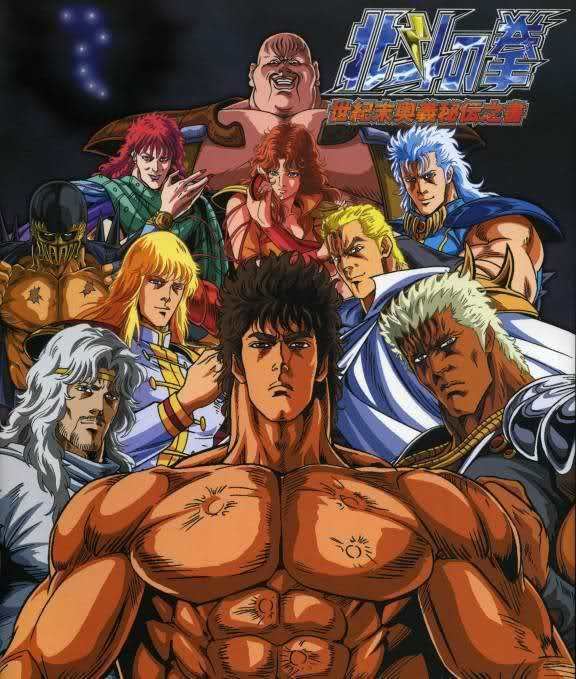 | ||
Original run September 13, 1983 – August 8, 1988 Adaptations DD Fist of the North Star, Fist of the North Star (1986), Fist of the North Star (1995) Main characters Similar Fist of the Blue Sky, Dragon Ball, Saint Seiya: Knights of, DD Fist of the North Star, Sakigake!! Otokojuku | ||
Fist of the North Star (Japanese: 北斗の拳, Hepburn: Hokuto no Ken, lit. "Fist of the Big Dipper") is a Japanese manga series written by Buronson and illustrated by Tetsuo Hara. Serialized in Weekly Shōnen Jump from 1983 to 1988, the 245 chapters were initially collected in 27 tankōbon volumes by Shueisha. Set in a post-apocalyptic world that has been destroyed by a nuclear war, the story centers on a warrior named Kenshiro, the successor of a deadly martial art style known as Hokuto Shinken, which gives him the ability to kill most adversaries from within through the use of the human body's secret vital points, often resulting in an exceptionally violent and gory death. Kenshiro dedicates his life to fighting against the various ravagers who threaten the lives of the weak and innocent, as well as rival martial artists, including his own "brothers" from the same clan.
Contents
- Plot
- Production
- Manga
- Prequel
- Spin off works
- TV series
- Films and OVAs
- Novels
- Live action film
- Video games
- Reception
- References
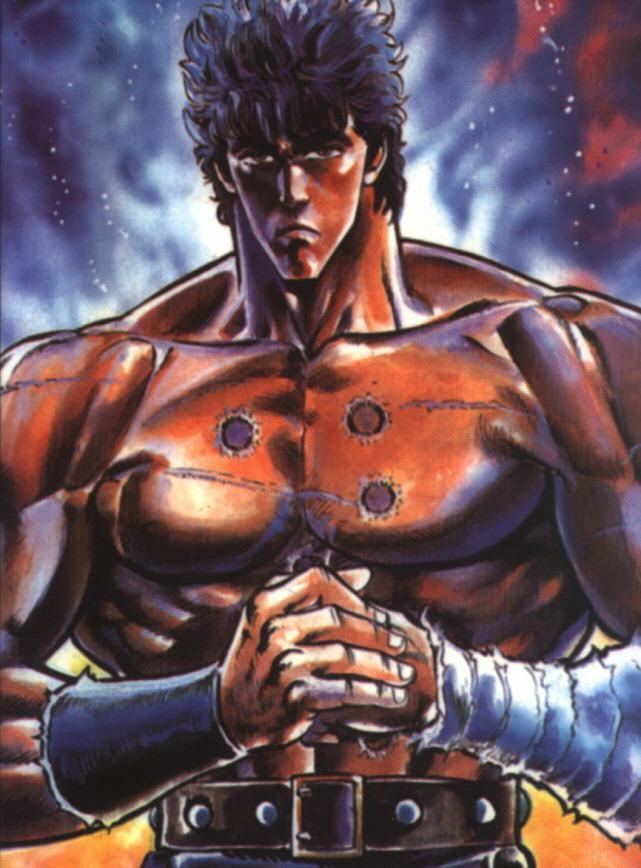
Fist of the North Star was adapted into two anime TV series produced by Toei Animation, which together aired on Fuji TV and its affiliates from 1984 through 1988, comprising a combined total of 152 episodes. Several films, OVAs, and video games have been produced as well, including a series of spin-offs centering on other characters from the original story.

The original manga was published in English by Viz Communications as a monthly comic book, and later by Gutsoon! Entertainment as a series of colorized graphic novels, although neither translation was completed. English adaptations of other Fist of the North Star media have been licensed to other companies, including the TV series and the 1986 film.
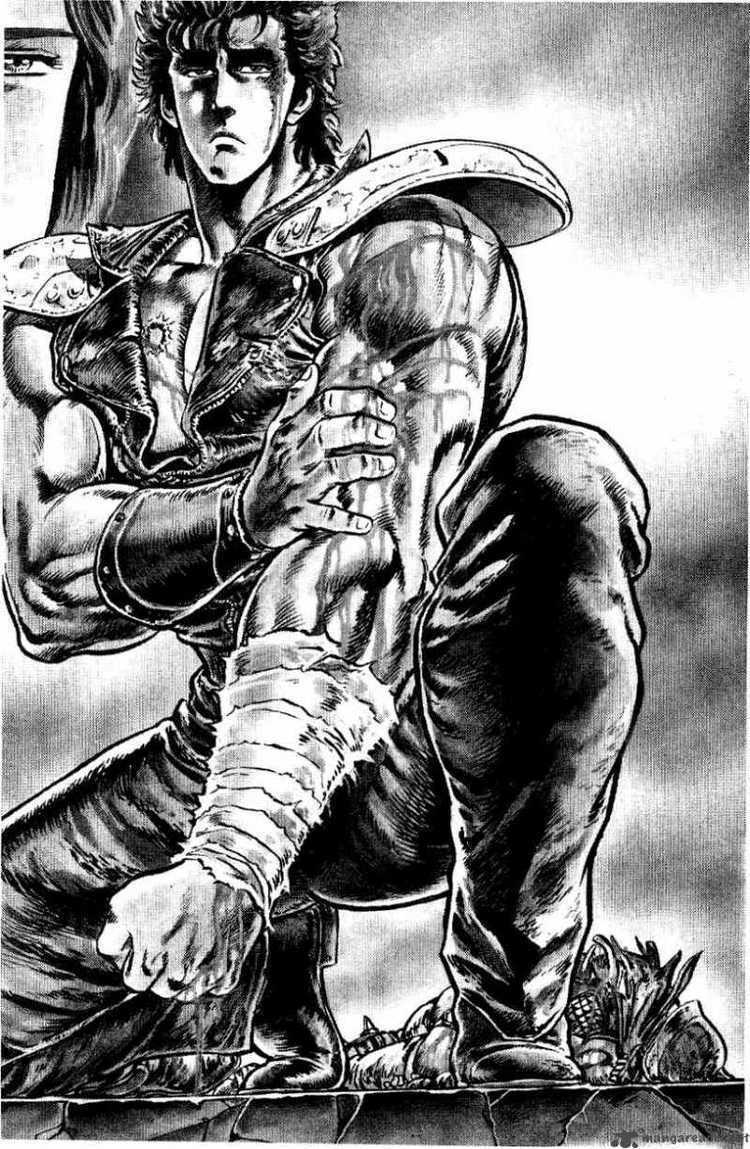
Plot
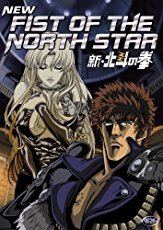
In the 1990s, civilization was ruined as a result of a worldwide nuclear war and many creatures died out. In spite of these events, 30% of mankind survived and entered an age where the strong ruled over the weak, as the few survivors fought over whatever supply of food and uncontaminated water remained in the wasteland of the world.
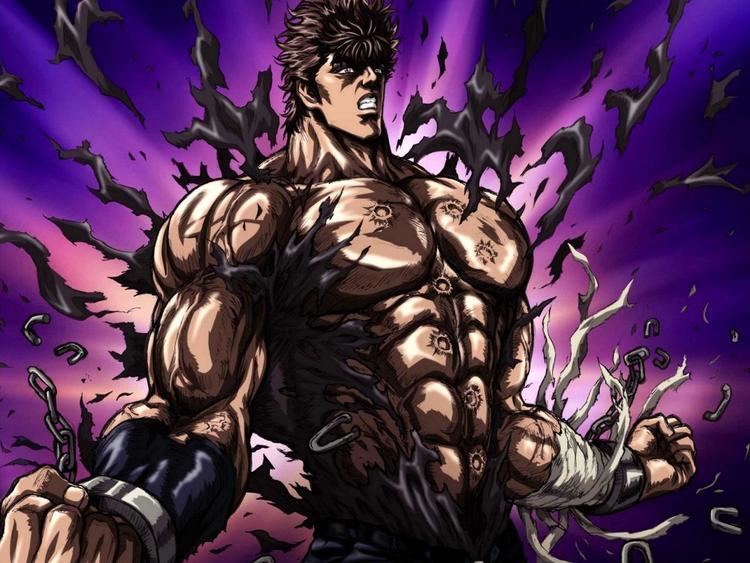
Kenshiro, successor to the ancient assassination art of "Hokuto Shinken", wanders into a village in search of water when he is caught in a trap and imprisoned by the local defense force. In prison, he befriends a young orphaned girl named Rin who nursed him back to health. When the village is attacked by a biker gang and Rin is taken hostage by their leader, Ken breaks free from his cell and rescues Rin, defeating the gang leader with his deadly martial art technique. Kenshiro leaves the village and continues his journey, now accompanied by a young thief named Bat. He becomes involved against the King organization after witnessing the many atrocities they have committed. As he infiltrates the gang's stronghold in the city of Southern Cross, he finds out that the leader of King is his old nemesis, the Nanto Seiken master Shin, the man who engraved the seven scars on Kenshiro's chest and kidnapped his fiancée Yuria. Kenshiro emerges victorious in his rematch with Shin, only to find out from Shin that Yuria killed herself in despair. Shin, not wanting to die by Kenshiro's hand, kills himself in the same manner.

Kenshiro continues his journey, fighting against the Golan army, Jackal's gang and the Fang Clan. After being reunited with Rin and meeting new allies such as the woman warrior Mamiya and the Nanto Suichōken successor Rei, Kenshiro learns that Jagi, a violent thug who sought to torment Kenshiro after losing the Hokuto Shinken succession to him, is still alive. Jagi seeks vengeance against Kenshiro by committing heinous crimes while impersonating him, seeking to defame Kenshiro, but is quickly exposed and eliminated. Just before dying, however, Jagi discloses to Kenshiro that their other two brothers-in-training are still alive. Kenshiro goes on to search for the second brother, a gentle healer named Toki, and learns that he is being kept prisoner in the dungeon city of Cassandra. After rescuing Toki, Kenshiro learns that Raoh, the eldest of the four brothers, has become a ruthless warlord known as "Ken-Oh" and is now seeking to conquer the post-apocalyptic world. Kenshiro goes on to challenge Raoh, but the long grueling battle ends in a stalemate and the two warriors are forced to settle their differences another day. Rei is fatally wounded as a result of a previous battle with Raoh and he spends the last few days of his life tracking down his nemesis Juda, successor of Nanto Kōkakuken, who once tormented Mamiya in the past. After defeating Juda, Rei goes on to die, at peace with himself.
With Raoh still recovering from his wounds, another warlord, the Nanto Hōōken successor Thouzer, proclaims himself as the Holy Emperor. Kenshiro joins a resistance movement led by an old benefactor, the Nanto Hakuroken successor Shew. When Shew is captured and executed by Thouzer, Kenshiro confronts Thouzer and foils his ambitions. With Thouzer now gone, Raoh recovers from his wounds and goes on to resume his reign of conquest. Toki, who is on the verge of dying as a result of intense radiation poisoning, challenges Raoh as part of a childhood promise they made to each other, but is ultimately no match for him. Raoh can't bring himself to land a killing blow on his own brother, and leaves after defeating Toki. After Toki dies in a battle against the freelance warrior (and Yuria's brother) Ryuga, Kenshiro is left as the only one who can defeat Raoh.
The Last General of Nanto appears and decides to side with Kenshiro in order to defeat Raoh, sending out her five guardians, the Goshasei, after Raoh. Kenshiro and Raoh both learn that the General's true identity is Yuria, Kenshiro's missing fiancee, who had been saved by the Goshasei after her suicide attempt early on in the story. After a series of numerous events and battles, Kenshiro emerges victorious over Raoh and he is finally reunited with Yuria. However, the victory is bittersweet, as Yuria, having affected by radiation sickness, has only a few years left to live. Kenshiro leaves his friends and spends the final few years of Yuria's life with her.
The peace that follows Raoh's downfall does not last long and the world returns to turmoil several years later. Kenshiro rejoins his former traveling companions, Bat and Rin, in their battle against an oppressive Empire, fighting under the banner of the Hokuto Army. The Hokuto Army rescues the rightful Empress Rui, who is also Rin's estranged twin sister, foiling the plot of the usurper Jakoh, who was blackmailing Rui's guardian, the Gento Kōken successor Falco, to do his evil bidding.
However, Rin is taken captive by the remnant of Jakoh's forces and is sent off to the mysterious Kingdom of Shura, a brutal land of warriors ruled by three overlords who have all mastered the ways of Hokuto Ryūken, a martial art which branched off from the same clan alongside Hokuto Shinken into the ways of darkness. Kenshiro defeats Han, the third-ranking overlord, who reveals that the Kingdom of Shura was Kenshiro's birthplace. Moreover, Kenshiro also learns that Hyou, the second overlord, is his biological older brother. After a grueling battle, Hyou and Ken reconcile their differences and Kenshiro seeks out the highest-ranking and most powerful of the three overlords, Kaioh, who is Raoh's biological older brother, and plans a conquest to rule the post apocalyptic world in the name of evil after wiping out the followers of Hokuto Shinken. However, Kenshiro is ultimately helpless against Kaioh's evil powers, and the man known as Shachi, a feared righteous warrior throughout Shura, helps him nearly escape death. After having recovered from the harrowing fight, Hyou reveals to Kenshiro that the homeland of the progenitor clan of all Hokuto style martial arts, the Hokuto Soke, lies in Shura, and holds the secrets of overcoming Kaioh's overwhelming power. Upon gaining the favor of the spirits of the Hokuto Soke, and rightfully bestowed the ancestral techniques in a race against Kaioh, Kenshiro goes to confront the conqueror. When Kenshiro and Kaioh meet up again, the latter hits a pressure point on Rin that renders her unconscious and amnesiac and will force her to fall in love with the first person she sees; Kaioh then sends her away on a horse before rematching Kenshiro. The final battle concludes with Kenshiro defeating Kaioh, who makes his peace with Hyou as both of them pass away.
Afterward, Kenshiro rescues Rin and leaves her under Bat's care as he goes on an adventure with Raoh's orphaned son Ryu. Meanwhile, a villain named Bolge appears, seeking revenge against Kenshiro for blinding him in a fight a long time ago. Bat brands himself with Kenshiro's seven scars and fights in his place, only to be crucified by Bolge and tortured to near-death. Kenshiro rescues Bat, then fights and kills Bolge, while Rin regains her memories and professes her love to a recovering Bat. Afterwards, Kenshiro leaves and continues his role as the Post-Apocalyptic Savior, defending the weak and fighting off the greedy and violent, as the world finally begins to recover from the nuclear war.
Production
Tetsuo Hara has stated that he came up with the idea of Hokuto no Ken from his editor Nobuhiko Horie. According to Hara, Horie suggested to him that he should draw a manga about "a martial artist who destroys his opponents by striking their acupressure points" based on Hara's aspiration to draw a manga about martial arts and his knowledge of pressure points. At the time, Hara was having trouble breaking into the market, as his first series, the Iron Don Quixote, was cancelled ten weeks after its debut. A prototype version of Hokuto no Ken was published as a one shot story in the April 1983 issue of Fresh Jump, which was followed by Hokuto no Ken II, a second one-shot published in the June 1983 issue. Both stories are collected in the second tankōbon volume of Tetsu no Don Quixote.
The two one-shots were well received in the reader's surveys of Fresh Jump and Tetsuo Hara was commissioned to turn Hokuto no Ken into a weekly series. Buronson was assigned to work with him as writer for the serialized version. The storyline was revamped, with the 1980s present-day setting in the original version replaced by post apocalyptic future world, and the protagonist Kenshiro, originally a teenager framed for a crime he didn't commit in Hara's prototype story, became an older and more stoic hero with a tragic past. Originally, Tetsuo Hara and Buronson were contracted to do Hokuto no Ken for a three-year run, but due to its popularity and the publisher's demand, it was extended to a five-year run.
Manga
Hokuto no Ken premiered in Japan in Weekly Shōnen Jump in Issue 41 on September 13, 1983 and was serialized weekly until Issue 35 of 1988, lasting 245 chapters. The original collected volumes or tankōbon of Hokuto no Ken were published under Shueisha's Jump Comics imprint and spans 27 volumes. During the 1990s, Shueisha reprinted Hokuto no Ken in 15 hardcover aizōban editions, as well as 15 corresponding economy-sized bunko editions. A 14-volume Kanzenban edition was published by Shogakukan in 2006 under the Big Comics Selection imprint, featuring the original water-colored artwork from the Weekly Shōnen Jump serialization. It has also been released in 27 digital e-book editions.
To celebrate the series' 30th anniversary, Tokuma Shoten re-published Hokuto no Ken in an Extreme Edition comprising 18 volumes that were published two books per month from September 20, 2013 through July 20, 2014 (with a three-month gap between January and April 2014). These Extreme Editions feature new cover illustrations by Tetsuo Hara and reprints all the colorized artwork from the original Weekly Jump serials. Vol. 11 features an additional chapter by Buronson and Hara, originally published in two parts in the May and June 2014 issues of Monthly Comic Zenon, titled Hokuto no Ken: Last Piece. The storyline covers the gap between the defeat of Raoh and Kenshiro's later reunion with the grown Bat and Rin, centering around Raoh's former steed Kokuoh and how he lost his left eye during the time span. It also introduces a new character named Shōza, the son of Jūza of the Clouds.
Viz Communications published the first sixteen chapters of Fist of the North Star in English as an eight-issue monthly comic in 1989, which were later reprinted in a single graphic novel collection in 1995. During the same year, Viz resumed publication of the series as a monthly comic until 1997, lasting eighteen issues (adapting chapters 17-44), which were subsequently republished in three additional graphic novel volumes. A second English adaptation was published by Gutsoon! Entertainment under the title of Fist of the North Star: Master Edition,which featured newly colorized artwork, but retained the original right-to-left orientation. Each volume from the fourth one and onward featured new cover illustrations by Tetsuo Hara that were made specifically for the Master Edition. The Master Edition was published from 2002 to 2003, lasting only nine volumes, due to Gutsoon!'s withdrawal from the North American market.
Prequel
In 2001, Tetsuo Hara began working on a Fist of the North Star prequel titled Fist of the Blue Sky, which was serialized in Weekly Comic Bunch until 2010. Set during the Second Sino-Japanese War in 1935, the story stars Hokuto Shinken predecessor and Kenshiro's namesake, Kenshiro Kasumi. An English adaptation of Fist of the Blue Sky was published in North America by Gutsoon! Entertainment in the now-defunct manga anthology Raijin Comics. Four collected volumes were published before the company went out of business.
Spin-off works
A series of Fist of the North Star spinoffs began to be published in Weekly Comic Bunch and Big Comics Superior later. This lineup of titles has been dubbed the Hokuto Gaiden series, as each title focuses on a particular supporting character from the original manga. The following titles had been published so far:
TV series
Hokuto no Ken was first adaptated into a weekly anime series by Toei Animation. The series aired on Fuji Television from October 11, 1984 to March 5, 1987, lasting 109 episodes. It was immediately followed by a sequel series, titled Hokuto no Ken 2, which aired from March 13, 1987 to February 18, 1988, lasting for 43 additional episodes (a combined total of 152 episodes between both series).
The full series was never released on VHS in Japan, although three hour-long compilation movies were produced by Toei Video covering the first, second and fourth story arcs in that order. On July 24, 2002, Universal Music released a Region 2 DVD box set containing all 152 episodes spread across 26 discs. These discs were later released as individual volumes from May 21, 2003 through January 21, 2004. Three "best of" DVD compilations were also released in 2005, each featuring seven key episodes from the series. On March 28, 2008, Avex released a 25th anniversary edition box set featuring new video transfers of all 152 episodes remastered in high definition, once again spread across 26 discs. This set also features two additional discs of bonus content (including the aforementioned compilation movies).
The first 36 episodes of the first series were translated and dubbed by Manga Entertainment in 1999, although only 24 episodes were released on VHS (spread across eight tapes). All 36 episodes of the dub version were aired on Showtime Beyond in the United States and on Sci-Fi Channel in the United Kingdom, and were later released on DVD in 2003 (spread across six individual volumes). In 2008, the US subsidiary of Toei Animation produced an official subtitle-only translation of all 152 episodes, which were released on various paid download and streaming websites available only for North American customers. Discotek Media announced on October 2, 2009 that they have licensed the entire Fist of the North Star TV series. The first two boxsets were released in that year, and the latter two in 2011. The episodes used the sames transfers from the 2008 DVD box set in Japan, although it did not contain any of the special features. The first set featured the first 36 episodes along with Manga Entertainment's English dub, and a Japanese audio option with English subtitles; these subtitles were adjusted from the translation of Toei's streaming episodes. Discotek later released all discs from all four boxsets (a total of 21 discs) together in one set, Fist of the North Star: The Series - The Complete Series Collection, on March 25, 2014.
In 2009, William Winckler Productions produced six compilation movies voiced in English. The movies cover major story arcs from the TV series, each one centering on a specific character (Shin, Rei, Toki, Thouzer, Raoh, and Kaioh). These compilation movies had not been officially released in North America and Europe yet, but were distributed to video streaming websites in Japan in 2012.
Films and OVAs
The first animated feature film based on the series, simply titled Fist of the North Star, was produced by Toei Animation, which premiered in Japan on March 8, 1986. Produced by the same staff and cast who worked on the TV series, the movie adapts the storyline of the manga from the beginning and up to Kenshiro's first fight with Raoh, taking several liberties with the order of events and how the story unfolds. An English-dubbed version produced by Streamline Pictures was first released in 1991 in North America and in 1994 in Europe and Australia by Manga Entertainment.
In 2003, a three-episode original video animation (OVA) mini-series titled New Fist of the North Star was produced by OB Planning, based on a 1996 Hokuto no Ken novel, Jubaku no Machi. An English dub version was produced by ADV Films in 2004.
In 2005, North Stars Pictures and TMS Entertainment announced the development of a five-part film series titled Fist of the North Star: The Legends of the True Savior. The series is composed of three theatrical films and two OVAs, which were released during a three-year period between 2006 throughout 2008, culminating with the 25th anniversary of the franchise.
Novels
An original novel was written by Buronson and Tetsuo Hara titled Shōsetsu Hokuto no Ken: Jubaku no Machi which was published by Jump Novel in Japan on December 13, 1996. The novel was the basis of the later three-episode OVA series New Fist of the North Star. A novelization of the movie Legend of Raoh: Chapter of Love in Death written by Eiichi Sakaki was published by Tokuma Novels on March 10, 2006.
There has also been two cell phone novels released via the mobile site Hokuto no Ken DX. Raoh Gaiden, a novelization of the manga of the same name, and Kenshiro Gaiden, an original novel by Jotaro Higashi.
Live-action film
An American-produced live-action movie version of Fist of the North Star was released in 1995, directed by Tony Randel based on a script by Peter Atkins and Wynne McLaughlin. The movie, loosely based on the Shin storyline of the manga, stars Gary Daniels as Kenshiro, Costas Mandylor as Shin and Japanese actress Isako Washio as Yuria, with Malcolm McDowell as Ryuken and Chris Penn as "Jackal" (actually a renamed Jagi). It also featured a cameo by professional wrestler Big Van Vader as Goliath, and Kevin Arbouet as "Rao" (unrelated to the actual Raoh from the manga). The movie was released straight-to-video in the US and Japan (though it did receive a premiere on HBO). The Japanese dubbed version used the original voice actors from the 1980s anime series.
Video games
Numerous video game titles based on the Fist of the North Star have been produced since the 1986 release of Enix adventure game, simply titled Hokuto no Ken for the PC-88. The earlier games in the franchise were released by Sega for the Mark III and Mega Drive and by Toei Animation for the Nintendo's Famicom, Game Boy and Super Famicom. These titles included side-scrolling action games, role-playing video games and competitive-style fighting games. The two Sega titles were released overseas without the Hokuto no Ken license under the titles of Black Belt and Last Battle, while a couple of the Toei titles, namely Fist of the North Star for the NES and Fist of the North Star: 10 Big Brawls for the King of Universe for the Game Boy, had American releases with the license intact. Further games were released for the Sega Saturn, PlayStation, Arcade, PlayStation 2 and Nintendo DS among other platforms. In 2000, Konami released an arcade game based on the franchise titled Fighting Mania. Another arcade game, a 2D fighting game simply titled Fist of the North Star, was produced by Sega and Arc System Works in 2005. Both games saw international distributions, although the PS2 version of the fighting game was released exclusively in Japan. Tecmo Koei produced a Dynasty Warriors spinoff focusing on the events from the first half of the manga, titled Fist of the North Star: Ken's Rage. It which was released in Japan on March 25, 2010, and later in North America on November 2, 2010, and Europe on November 5, 2010. A sequel, Fist of the North Star: Ken's Rage 2, expanded on the first game and incorporated the events from the second half of the manga. It was released in Japan on December 20, 2012, and in North America on February 5, 2013.
In addition to traditional video games, the franchise has inspired a series of typing software, an online MMORPG, and numerous pachinko and pachislot machines, mainly produced by Sega Sammy Holdings.
Reception
Fist of the North Star was one of Weekly Shōnen Jump's most popular titles during the 1980s. It is one of the best-selling manga series in history, having sold approximately 100 million copies. In a poll conducted by TV Asahi in 2005, the Fist of the North Star anime series ranked 26 in a list of Top 100 Anime series. In a second poll in 2006, it ranked 89. In a celebrity version of the poll, it ranked 15.
